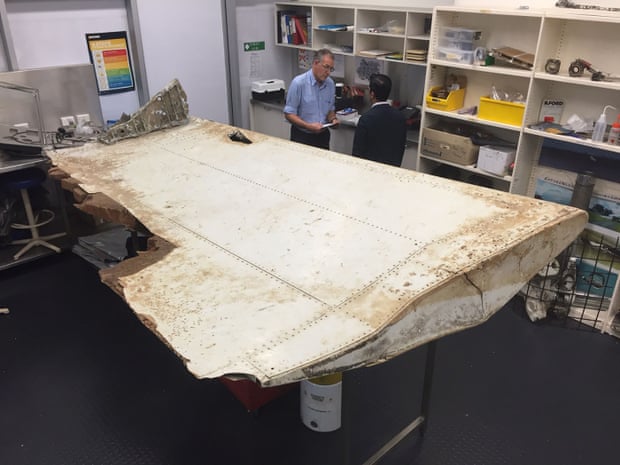
The underwater search for missing Malaysia Airlines flight MH370 has come to an end, with passengers’ families informed that the effort to find the plane has been suspended.
Next of kin were told in an emailed statement on Tuesday that Australian authorities’ underwater search of 120,000 sq km in the southern Indian ocean had concluded without success after more than two years.
The MH370 Tripartite Joint Communiqué was co-signed by the transport ministers of Malaysia, China and Australia, representing the three countries involved in the search. It was made public at 2pm Malaysia time.
“Today the last search vessel has left the underwater search area. Malaysia Airlines flight MH370 has not been located in the 120,000 square-kilometre underwater search area in the southern Indian Ocean,” it read.
“Despite every effort using the best science available, cutting edge technology, as well as modelling and advice from highly skilled professionals who are the best in their field, unfortunately, the search has not been able to locate the aircraft.
“The decision to suspend the underwater search has not been taken lightly nor without sadness.”
Flight MH370 disappeared on 8 March 2014, vanishing from radar shortly after take-off from Kuala Lumpar en route to Beijing. The plane is believed to have crashed in the Indian Ocean, claiming the lives of all 239 crew and passengers on board.
The announcement to suspend the search comes six weeks out from the third anniversary of the plane’s disappearance, with the unsuccessful conclusion of the Australian Transport Safety Bureau’s search of the so-called “seventh arc”.
At a tripartite meeting in July 2016, the three transport ministers had acknowledged the “diminishing” likelihood of finding the plane. If the full 120,000 sq km area was searched without success, the effort was to “not end, but be suspended” indefinitely, they said – reiterating their earlier resolution made in April 2015.
In December, the ATSB said it had a “high degree of confidence” that the wreck would not be found in the seventh arc – the first time it had publicly lost confidence in the search zone. Instead, it highlighted a new area of approximately 25,000 sq km – between latitudes 33 degrees south and 36 degrees south – as “the area with the highest probability of containing the wreckage of the aircraft”.
The tripartite statement said Tuesday’s announcement was consistent with its decision made in July 2016.
“Whilst combined scientific studies have continued to refine areas of probability, to date no new information has been discovered to determine the specific location of the aircraft.”
The flight was carrying 152 Chinese nationals and 50 from Malaysia, as well as passengers from Australia, Canada, France, Hong Kong, India, Indonesia, Iran, the Netherlands, New Zealand, Russia, Taiwan, Ukraine and the United States.
Chandrika Sharma, of Chennai in India, was among the 239 people on board MH370.
“This decision appears premeditated and a betrayal of the commitment to the families and the public that the governments are committed to the search,” K S Narendran, her husband of 25 years, told the Guardian.
“It must also come as a blow to all this who have worked tirelessly to find answers and find the plane.”
Voice370, a group representing passengers’ next of kin, accused the governments of being closed to the possibility of extending the search.
“Expecting to determine ‘the precise location of the aircraft’ before continuing the search was at best an erroneous expectation and at worst a clever formulation to bury the search. Why would you need to search if you already knew the precise location of the aircraft?
“In our view, extending the search to the new area defined by the experts is an inescapable duty owed to the flying public in the interest of aviation safety. Commercial planes cannot just be allowed to disappear without a trace.”
The decision not to extend the search to the smaller area pinpointed by the ATSB suggested to Voice370 that officials had lost confidence in the data used to determine the search area.
The statement ended with an appeal to the governments to reconsider their decision.
The search for MH370 has been a multimillion-dollar effort on the parts of Australia, Malaysia and China. The operation is believed to have cost around AU$180m, paid for by Australia and Malaysia. China donated AU$20m in funding and equipment.
Progress was frustrated by difficulties in reaching the search zone and the largely uncharted part of the Indian Ocean it was believed to have crashed in. The final 20,000 sq km in particular were delayed by poor weather conditions throughout 2016.
But investigators remained optimistic, with Martin Dolan, the head of the ATSB, expressing confidence in March 2016, the two-year anniversary of its disappearance, that the plane would be found within that 120,000 sq km area.
In July 2015 authorities had a breakthrough, when they found debris on the island of Réunion that was later confirmed to be a flaperon from the flight.
Several more pieces of debris were confirmed to have come from MH370, including a wing flap found on an island off the coast of Tanzania in June and sent to Canberra for analysis that was found to be from a Boeing 777.
Investigators say the failure to find the wreckage does not mean all search efforts will end. But those seeking answers for the disappearance of the plane – and those on board – now face the prospect that the fate of MH370 might never be known.
(culled from www.theguardian.com)
No comments:
Post a Comment